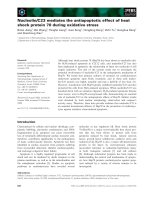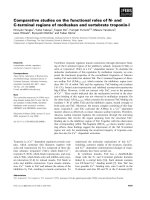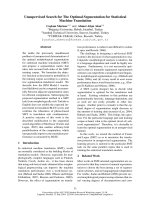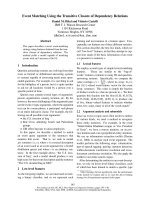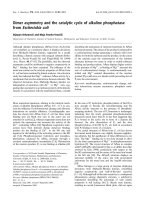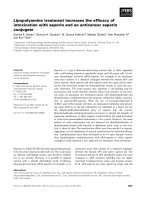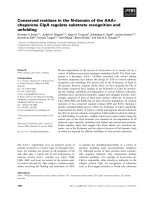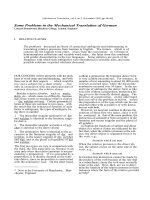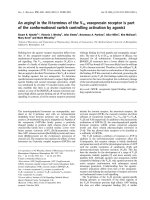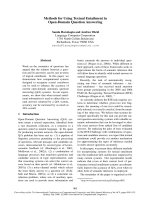Báo cáo khoa học: Methods to monitor the quaternary structure of G protein-coupled receptors doc
Bạn đang xem bản rút gọn của tài liệu. Xem và tải ngay bản đầy đủ của tài liệu tại đây (252.46 KB, 12 trang )
MINIREVIEW
Methods to monitor the quaternary structure of
G protein-coupled receptors
Graeme Milligan
1
and Michel Bouvier
2
1 Molecular Pharmacology Group, Division of Biochemistry and Molecular Biology, Institute of Biomedical and Life Sciences,
University of Glasgow, UK
2 Biochemistry, Universite de Montreal, Quebec, Canada
Introduction
In recent times, the view that G protein-coupled recep-
tors (GPCRs) are single polypeptides that function as
isolated monomers has been challenged, and largely
supplanted, by results consistent with the existence of
GPCRs as dimers or higher-order oligomers. Data in
support of GPCRs being able to form dimers or oligo-
mers had been scattered throughout the literature [1].
However, at least in part because expression of a single
GPCR cDNA in heterologous cell systems generally
resulted in production of a ligand-binding site with the
expected pharmacology and the capacity to activate
G proteins and hence initiate signal transduction, little
thought was given to potential quaternary structure.
This is despite the fact that dimerization of proteins,
as a route to function, is one of the most common
themes in biology [2]. This had been well established
previously for other classes of transmembrane recep-
tors. Key to a broad appreciation of the potential of
dimerization for GPCR function was the demonstra-
tion that the c-aminobutyric acid (GABA)
B
-receptor,
long recognized as a GPCR, was an obligate hetero-
dimer [3,4]. Even though the GABA
B
R1 polypeptide
is a seven transmembrane protein able to bind both
GABA and a GABA
B
receptor antagonist [5], when
expressed alone this polypeptide is not transported to
the cell surface, does not have the expected characteris-
tics and affinity for binding of agonists and cannot
activate G protein signalling. Cell surface delivery and
function requires the coexpression of a second, closely
related seven transmembrane polypeptide, the
GABA
B
R2, which although unable to bind GABA
B
receptor ligands, allows cell surface delivery of the
GABA
B
R1. The heterodimeric complex then functions
with pharmacology akin to the native receptor. Subse-
Keywords
dimerization; functional reconstitution;
G protein coupled receptor; immuno-
precipitation; resonance energy transfer
Correspondence
G. Milligan, Davidson Building, University of
Glasgow, Glasgow, G12 8QQ Scotland, UK
Fax: +44 141330 4620
Tel: +44 141330 5557
E-mail:
(Received 16 February 2005, accepted
4 April 2005)
doi:10.1111/j.1742-4658.2005.04731.x
A wide range of approaches has been applied to examine the quaternary
structure of G protein-coupled receptors, the basis of such protein–protein
interactions and how such interactions might modulate the pharmacology
and function of these receptors. These include coimmunoprecipitation, var-
ious adaptations of resonance energy transfer techniques, functional com-
plementation studies and the analysis of ligand-binding data. Each of the
available techniques has limitations that restrict interpretation of the data.
However, taken together, they provide a coherent body of evidence indica-
ting that many, if not all, G protein-coupled receptors exist and function
as dimer ⁄ oligomers. Herein we assess the widely applied techniques and
discuss the relative benefits and limitations of these approaches.
Abbreviations
BRET, bioluminescence resonance energy transfer; DOP, delta opioid peptide; eYFP, enhanced yellow fluorescent protein; FRET,
fluorescence resonance energy transfer; GPCRs, G protein-coupled receptors; G(C,Y)FP, green (cyan, yellow) fluorescent protein;
NEM, N-ethyl maleimide.
2914 FEBS Journal 272 (2005) 2914–2925 ª 2005 FEBS
quently, it has become clear that sweet and umami
taste responses are also generated by obligate hetero-
dimer pairs of T1 taste receptors [6] and both homo-
and heterodimerization of other family C receptors is
firmly established. This topic is covered in the accom-
panying review by Pin and colleagues [7]. Analysis of
the importance of quaternary structure for function of
the rhodopsin-like family A GPCRs has been more
recalcitrant to analysis, as examples of obligate hetero-
dimerization akin to the GABA
B
receptor have not
been noted, although there are reports, for example, of
the requirement for heterodimeric interactions to allow
cell surface delivery of certain a
1
-adrenoceptor sub-
types [8] and olfactory receptors [9]. Nevertheless, it is
now generally accepted that family A GPCRs can exist
as dimers and ⁄ or higher order oligomers [10–12]. A
growing database on the formation of GPCR dimers
prior to membrane delivery [13–15] and the potential
that GPCRs can bind to single heterotrimeric G pro-
teins as dimers [16] is certainly consistent with such
a receptor dimer model. However, the importance of
dimerization for receptor function and regulation in
physiological systems remains to be demonstrated
unambiguously. A significant number of recent reviews
have covered these topics [11,12,17] and the purpose of
the current piece is to critically evaluate the approa-
ches used to explore dimerization of class A GPCRs.
Coimmunoprecipitation
The ability to differentially epitope-tag GPCRs has
been central to the widespread use of coimmunoprecipi-
tation following coexpression of two forms of the same
GPCR in heterologous expression systems. Initially
Hebert et al. [18] coexpressed c-myc- and HA-tagged
forms of the b
2
-adrenoceptor in insect Sf9 cells and
demonstrated interaction between the two forms of the
receptor as both were present in immunoprecipitates
generated using either anti-HA or anti-c-myc Igs. These
studies also provided a series of key controls (a) in a
lack of cross-reaction between the antibodies and the
alternately tagged form of the receptor and (b) in a lack
of coimmunoprecipitation of the HA-tagged b
2
-adreno-
ceptor when coexpressed with a c-myc-tagged form of
the M
2
muscarinic acetylcholine receptor. These studies
also noted the resistance to monomerization during
SDS ⁄ PAGE of at least a proportion of the coimmuno-
precipitated receptors; this is a commonly observed
feature in many such studies. Despite such apparent
receptor dimerization (and indeed multimerization)
being detected following SDS ⁄ PAGE resolution of
simple membrane preparations of transfected cells and
even native tissues [19], detection of SDS-resistant
higher-order structures was reminiscent of protein
aggregation, a well-appreciated potential artefact
resulting from membrane protein solubilization. There-
fore, the hydrophobicity of the transmembrane
domains of GPCRs raised concerns that apparent
coimmunoprecipitation might reflect little more than
nonspecific aggregation following detergent extraction
of proteins from cells and membranes. This resulted in
widespread incorporation of mixed samples into co-
immunoprecipitation studies to counter this concern.
In such experiments detergent extracts of cells or
membranes, each expressing only one of the tagged
GPCRs, are combined prior to the immunoprecipitation
step. This is generally considered a sound means to elim-
inate nonspecific aggregation as a potential explanation
of spurious coimmunoprecipitation (Fig. 1).
Coimmunoprecipitation has been of particular use in
efforts to identify heterodimeric interactions between
GPCRs [20]. However, coimmunoprecipitation studies
such as that of Salim et al. [21] intimated widespread
interactions between coexpressed GPCRs and, assu-
ming that interaction between different GPCRs is not
a purely stochastic process, raised further questions
about the use of coimmunoprecipitation in the absence
of further supporting evidence of protein–protein inter-
Fig. 1. Differentially epitope-tagged forms of the a
1b
-adrenoceptor
have to be coexpressed to be coimmunoprecipitated. N-terminally
Flag- or c-myc-tagged forms of the hamster a
1b
-adrenoceptor were
expressed individually (flag, myc) or coexpressed (flag + myc) in
HEK293 cells. Samples expressing each form of the receptor were
also mixed (mix). Lysates of cells were resolved by SDS ⁄ PAGE and
immunoblotted to detect expression of each form, or the samples
were immunoprecipitated using anti-Flag Ig, resolved by SDS ⁄
PAGE and then immunoblotted to detect c-myc immunoreactivity.
Coimmunoprecipitation was only observed from samples co-
expressing the two forms. Data are modified from [35].
G. Milligan and M. Bouvier GPCR quaternary structure
FEBS Journal 272 (2005) 2914–2925 ª 2005 FEBS 2915
actions. A key issue that remains overlooked in many
published coimmunoprecipitation studies is whether
the samples are fully solubilized prior to the immuno-
precipitation step. In many studies, centrifugation after
detergent extraction is limited to a short period in a
bench top microcentrifuge, with force in the region of
15 000 g. This is far too limited to ensure production
of a fully soluble fraction and it is suggested that, as
in many other protocols, centrifugation should be for
at least 60 min and > 100 000 g. As an alternative,
passage of the detergent-generated extract through a
0.22 lm filter would ensure removal of membrane frag-
ments that might contain both coexpressed forms of a
GPCR that are not actually physically in contact. The
addition of alkylating agents such as NEM and iodo-
acetamide in the lysis and solubilization buffers is also
recommended in order to prevent the formation of
spurious intermolecular disulfide bonds that could be
favoured by the oxidizing condition associated with
cell lysis. Notwithstanding these caveats, there is no
doubt that coimmunoprecipitation remains as the
starting point and, indeed at the heart, of many GPCR
dimerization studies. Indeed, despite the general pau-
city of specific and high affinity anti-GPCR sera, care-
fully controlled coimmunoprecipitation studies remain
the most practical means to explore, in particular,
GPCR heterodimerization in native tissues and can
provide key information to support GPCR dimeriza-
tion ⁄ oligomerization.
Coimmunoprecipitation of GPCRs, subsequent to
cross-linking with cell-impermeant cross-linking agents
has also provided a useful means to detect GPCR
dimers ⁄ oligomers in the plasma membrane. The intro-
duction of cysteine residues into specific locations in
transmembrane domains of class A GPCRs, that then
allow cross-linking by bi-functional reagents, is an
extension of the basic cross-linking and immunopre-
cipitation strategy but has the added advantage of
assisting identification of potential protein–protein
interaction sites in GPCR dimers [22,23] and determin-
ing whether ligand-binding modulates the organiza-
tional structure of a GPCR dimer ⁄ oligomer. Although
the concept of coimmunoprecipitation can be extended
easily to studies that employ cotransfection with three
or more forms of the same GPCR, each incorporating
a different tag, this has only been employed to date in
a limited manner. In one such example, where c-myc-,
FLAG- and HA-tagged forms of the M
2
muscarinic
receptor were coexpressed in insect Sf9 cells, Park and
Wells [24] were able to immunoprecipitate complexes
containing all three epitope tags, hence providing
evidence for complexes containing at least three GPCR
monomers.
Resonance energy transfer studies
Fluorescence resonance energy transfer
The green fluorescent protein (GFP) from Victoria
aequoria has found widespread use in cell biology to
monitor the expression and distribution of proteins
tagged with this polypeptide. Mutation of this protein
has produced a range of variants with altered spectral
characteristics, and pairs of these are able to function
as fluorescence resonance energy transfer (FRET) part-
ners. The most widely used pairing is a cyan fluores-
cent protein (CFP) as energy donor and a yellow
fluorescent protein (YFP) as an energy acceptor, but
other pairings are also practical. Obvious attractions in
the use of FRET for studies of GPCR dimerization ⁄
oligomerization include the capacity to monitor pro-
tein–protein interactions in intact living cells both in
cell populations and single cells. It can be combined
with cell imaging and photo-bleaching protocols to
examine the cellular location of such interactions in
specific subcellular compartments [25–27]. Photo-
bleaching of the energy acceptor construct also
provides an important control to demonstrate that
FRET-signals actually reflect energy transfer. Photo-
bleaching of the acceptor should result in increased
fluorescence output from the energy donor as well as
destruction of signal from the acceptor as no energy
transfer can then occur. This is a particularly import-
ant control as direct excitation of the energy acceptor
by the exogenous light source in sensitization FRET
experiments can generate background signals that can
be mistakenly interpreted as real FRET. Also, the
spectral overlap between the donor and acceptor emis-
sion spectra needs to be properly monitored and con-
trolled to determine the legitimate FRET signal. These
are not trivial issues as the contribution of the back-
ground signals can vary considerably depending on the
relative expression levels of the FRET partners and the
band pass width of the fluorescence excitation and emis-
sion detection systems.
Although some wild-type GFPs have the tendency
to oligomerize, a characteristic that could promote
artefactual oligomerization of the proteins attached to
them, variants such as CFP and YFP that have lower
affinity for one another, have been used successfully to
monitor the quaternary structure of several GPCRs.
FRET between CFP and YFP covalently fused to dis-
tinct GPCRs should occur only when the FRET part-
ners are brought within 100 A of each other; a
distance that falls within the dimensions anticipated
for GPCR dimers ⁄ oligomers [28]. The occurrence of
FRET between CFP- and YFP-fused GPCRs has
GPCR quaternary structure G. Milligan and M. Bouvier
2916 FEBS Journal 272 (2005) 2914–2925 ª 2005 FEBS
therefore been interpreted as strong evidence for the
existence of dimers or oligomers in living cells. As with
all approaches based on Fo
¨
rsters’ principles of reson-
ance energy transfer, the efficiency of transfer is deter-
mined both by the orientation of the energy transfer
partners and by the distance between them [28]. The
fact that the efficiency of transfer varies with the
6th-power of the distance between the fluorophores
presents both opportunities and limitations for the
analysis of data (Fig. 2). For instance, although the
FRET assays can be extremely sensitive detectors of
conformational changes that can reflect ligand-promoted
alteration in GPCR quaternary structure, the extent of
the D FRET observed for a given change is highly
dependent on the initial distance between the energy
donor and acceptor. For example, if constitutive dime-
rization of two GPCR FRET-tagged constructs brings
the energy transfer partners into very close proximity,
the energy transfer efficiency should be close to maxi-
mal and thus, a ligand-induced alteration in distance
between the energy-transfer partners would be poorly
reported (Fig. 2). In contrast, if the initial distance
between energy donor and acceptor is within the
region of the FRET R
0
(i.e.: the distance between the
donor and acceptor leading to 50% of the maximal
transfer efficiency) where the Denergy transfer ⁄Ddis-
tance is maximal, the same conformational change
would lead to large DFRET (Fig. 2). A range of fluor-
escence-based techniques, including intra- and inter-
molecular FRET, have been used to demonstrate
conformational changes in GPCR monomers upon
agonist binding [29,30] and recent studies have expan-
ded this to show that an agonist bound protomer of
the leukotriene B4, BLT1 receptor produces a confir-
mation change in the partner GPCR of the homodimer
[31]. It follows that reports of agonist-induced altera-
tions in GPCR quaternary structure based only on res-
onance energy transfer studies may simply reflect very
small conformational alterations in the GPCR that
are amplified by the high sensitivity of the resonance
energy transfer responses to distance and orientation
[32] (Fig. 2). Thus, a large increase or decrease in
FRET values observed upon ligand-binding cannot be
interpreted, as is too often the case, as an indication of
ligand-promoted dimer formation or dissociation.
The occurrence of FRET between fluorophore-
tagged GPCRs could result both from the formation
of dimers or of higher oligomeric structures. Unfortu-
nately, the currently available FRET techniques do
not permit one to distinguish easily between these two
possibilities. However, recent studies employing atomic
force microscopy to visualize the organizational struc-
ture of rhodopsin in murine rod outer segment discs
have shown higher order arrays of GPCRs [33,34] and
analysis of the results of GPCR transmembrane inter-
face mapping for both the complement C5a receptor
[23] and the a
1b
-adrenoceptor [35] have suggested ways
in which these GPCRs may organize into higher order
structures. Although not yet reported in relation to
GPCR quaternary structure, three component FRET
systems based on serial energy transfer from cyan to
yellow to red fluorescent proteins are available [36].
These and related systems may be invaluable to
explore the potential of higher-order GPCR oligomeri-
zation. They are, however, likely to suffer from low
sensitivity and thus, at least in the short term, the need
to express rather high levels of each component may
raise concerns in relation to the specificity of inter-
actions observed.
Quantitation of the fraction of a GPCR existing as
monomer vs. dimer or higher-order oligomer remains
a challenging task. Efforts to assess this for homo-
dimers of neuropeptide Y receptor subtypes were
based on FRET efficiency of appropriately tagged
GPCRs compared to the FRET signal produced by a
positive control generated by fusing together the two
FRET partner fluorescent proteins [37]. A similar
attempt was made for the b
2
-adrenoceptor homodimer
using another resonance energy transfer approach
known as bioluminescence resonance energy transfer
(BRET, see below) and using theoretical maximal
transfer values as the 100% dimer reference [38]. How-
Fig. 2. Variation in resonance energy transfer efficiency as a func-
tion of distance between energy donor and acceptor. Relationship
between the energy transfer efficiency (Y-axis) and the distance
between the energy donor and acceptor (X-axis). The distance is
expressed as the ratio of the distance ‘r’ separating the donor and
the acceptor over the distance resulting in 50% of the maximal
efficacy (R
0
). As indicated by the Fo
¨
rster equation, the efficiency of
transfer varies inversely with the 6th-power of the distance. The
extreme steepness of the relationship results in large changes in
RET for relatively small modifications in distance around the R
0
.In
contrast, large changes in the distance may not result in any RET
change when the distance is much smaller than the R
0
.
G. Milligan and M. Bouvier GPCR quaternary structure
FEBS Journal 272 (2005) 2914–2925 ª 2005 FEBS 2917
ever, the values obtained, which were in the region of
20–40% as dimers for the first study and greater than
85% in the dimeric form for the latter, required a
range of assumptions, including the fact that the recep-
tors existed as dimers and not larger oligomers. There-
fore, such estimates must be viewed as extremely
uncertain and require further experimental confirma-
tion. As indicated above, pictures of the structural
organization of rhodopsin in the disks from rod outer
segments from mice suggest a much higher level of
dimerization ⁄ oligomerization [33]. However, the high
concentration of rhodopsin in rods may impose order
and structural organization that is not required for
other class A GPCRs. Attempts to explore this by
employing discs from heterozygote rhodopsin knock-
out mice simply resulted in rod outer segments with
reduced volume rather than an alteration in the pattern
of interactions between rhodopsin monomers [34].
Time-resolved FRET
The capacity to image FRET signals in single cells and
in specific cellular compartments, including the plasma
membrane, provides a means to confirm interactions
between GPCR monomers at the surface of individual
cells [25–27]. A distinct FRET-based approach to mon-
itor interactions between GPCRs at the cell surface in
cell populations is based on time-resolved FRET using
anti-epitope tag Igs labelled with suitable FRET accep-
tor and donors [39]. N-terminally epitope-tagged forms
of GPCRs should only be accessible to such antibodies
in intact cells if they have been delivered successfully
and inserted into the plasma membrane. The use of
antibodies labelled with Europium chelates as energy
donor allows the use of ‘time-resolved’ protocols,
where short-lived fluorescence (up to some 50 ls)
derived from excitation of endogenous fluorophores is
allowed to decay before the long lived time-resolved
FRET signal is monitored over the ensuing 100–
200 ls. This generates improved signal-to-noise ratios.
Although employed in a limited number of studies to
date [40–43], limiting signals to GPCRs at the cell sur-
face using this approach has particular advantages for
analysis of GPCRs expressed in heterologous systems
where a significant fraction of the expressed GPCR(s)
can often be shown to be inside the cell, presumably
within the endoplasmic reticulum or as protein that
has failed to pass cellular quality control mechanisms
and is destined for degradation. Time-resolved FRET
pairings have also been used in membrane fractions
generated by sucrose density sedimentation to detect
dimers ⁄ oligomers of a
1a
-adrenoceptors in all mem-
brane fractions containing this GPCR as measured by
[
3
H]antagonist binding studies [43]. As this receptor
displays a high level of constitutive, agonist-independ-
ent internalization and recycling [44,45], the FRET
data are certainly consistent with at least a fraction of
the population of this receptor existing as a dimer ⁄
oligomer at all stages in its life history. The major
potential caveats for time-resolved FRET studies
relates to the obligatory use of antibodies. Appropriate
controls need to be performed to make sure that oligo-
merization of the partners is not promoted by the
bivalent nature of the antibodies. In studies assessing
the effect of ligand-binding on the quaternary structure
of the receptors, the possibility that the antibodies
could inhibit binding to the receptor also needs to
be controlled. Finally, the presence of an antibody
between the fluorophores and the proteins of interest,
increases the uncertainty concerning the minimum and
maximum FRET permissive distance.
Bioluminescence resonance energy transfer
Conceptually similar to FRET, except that energy is
donated to a fluorescent protein energy acceptor by
luciferase-mediated oxidation of a substrate, biolumi-
nescence resonance energy transfer (BRET) has
become almost as popular an approach as FRET. The
various benefits of BRET compared to FRET, partic-
ularly the lack of requirement of a light source to
excite the energy donor, have been discussed previ-
ously in more specialized articles [28]. In particular, we
should note that the lack of potential direct excitation
of the energy acceptor that can occur in FRET experi-
ments (see above) greatly simplifies controlling for the
background signals. However, a clear limitation of
BRET is that currently it is not sufficiently sensitive to
allow high resolution, single cell imaging and analysis
and therefore cannot usefully report on the subcellular
location of the signal. Although single cell BRET
signals resulting from the homodimerization of the
b
2
-adrenoceptor and melatonin MT1 and MT2
homodimers could be detected [32], obtaining subcellu-
lar resolution will require the development of more
sensitive cameras or of luminescence donors with
higher light output. In initial BRET studies, the energy
transfer pairing was Renilla luciferase and enhanced
YFP (eYFP) with h-coelenterazine acting as luciferase
substrate. However, the overlap between the spectrum
generated via this enzymic activity of luciferase
and the emission of light from eYFP subsequent to
energy transfer is substantial, resulting in a relat-
ively high background signal that needs to be carefully
controlled. As a means to improve this, the Renilla
luciferase substrate DeepBlueC, which results in emis-
GPCR quaternary structure G. Milligan and M. Bouvier
2918 FEBS Journal 272 (2005) 2914–2925 ª 2005 FEBS
sion of light that is substantially blue-shifted in com-
parison to the oxidation of h-coelenterazine, has been
used. The wavelength of the light emitted by the oxida-
tion of DeepBlueC is not well aligned for energy trans-
fer to eYFP but is suited for energy transfer to the
modified fluorescent protein GFP
2
and the output
from GFP
2
is relatively well resolved from the Renilla
luciferase ⁄ DeepBlueC oxidation spectrum [46] (Fig. 3).
This results in improved signal-to-noise ratios when
employing BRET
2
. The major limitation of BRET
2
is
the poor quantum efficiency associated with oxidation
of DeepBlueC resulting in much lower absolute signals
that thus necessitates higher GPCR expression levels.
With both their limitations and advantages, BRET
1
or
BRET
2
can be best suited to study specific proteins of
interest. Taking advantage of the distinct spectral char-
acteristics of the two BRET generations in the same
experiment, Perroy et al. [47] were able to monitor the
interaction between three partners simultaneously in
the same cell population. Such combinations between
different types of resonance energy transfer will cer-
tainly be increasingly used to examine the stoichio-
metry of GPCR complexes.
Following the initial report employing BRET that
examined interactions between Renilla luciferase- and
eYFP-tagged forms of the b
2
-adrenoceptor [48], BRET
has been used, to date, predominantly in ‘single point’
assays. In these, single amounts of Renilla luciferase
and fluorescent protein-tagged forms of a single
GPCR, to study homodimerization ⁄ oligomerization, or
pairs of GPCRs, to study potential heterodimeriza-
tion ⁄ oligomerization are cotransfected into host cells.
However, as with coimmunoprecipitation and FRET
studies, the intensity of the signal obtained does not
provide a measure of absolute, or even relative, inter-
action affinities between the GPCRs linked to the
BRET partners, because the extent of BRET signal is
dependent upon both distance between the energy
donor and acceptor and their orientation. The most
significant advance in this area since then has been the
introduction of ‘saturation’ BRET by Mercier and
colleagues [38]. Taking advantage of the possibility of
expressing differing amounts of energy donor and
acceptor-linked GPCRs in heterologous cells, these
studies demonstrated that an asymptotic approach to
a maximal BRET signal was obtained with increasing
energy acceptor ⁄ energy donor ratios. Saturation curves
so generated resemble ligand ⁄ GPCR binding curves
and, as such, the ratio of energy acceptor ⁄ energy
donor that generates half-maximal BRET signal can
provide a useful measure of the relative interaction
affinities of the GPCRs linked to the BRET reagents.
For example, although measurable BRET signals
can be recorded following coexpression of a DOP
opioid receptor-Renilla luciferase ⁄ a
1A
-adrenoceptor-
GFP
2
BRET pair in HEK293 cells that is commensur-
ate with the signals obtained for each of these two
GPCR homodimers, saturation BRET studies indica-
ted that the interaction affinity of this heterodimer ⁄
oligomer pairing was some 75-fold lower than for the
a
1A
-adrenoceptor homodimer ⁄ oligomer [43]. This sug-
gests that such a heteromeric pairing would be unlikely
to have physiological significance, even if interactions
can be monitored in heterologous expression systems.
Although it was noted in early studies that hetero-
dimeric interactions between structurally homologous
receptors were of higher affinity than interactions
between more distantly related class A GPCRs [46] it
is not inevitable that homodimer interactions will be of
higher affinity than heterodimeric interactions. Indeed,
in the studies of Ramsay et al. [46] hetero interactions
between the closely related KOP and DOP opioid
receptors were reported to be at least as high affinity
Fig. 3. Spectral properties of the energy donor and acceptor for the
two generations of BRET. Schematic representation of the emis-
sion spectra for Renilla luciferase (Rluc) using coelenterazine H
(BRET
1
) or DeepBlue Coelenterazine (BRET
2
) as substrates and of
the overlap between the emission spectrum of Rluc and the excita-
tion spectrum of the fluorescent energy acceptors YFP for BRET
1
and GFP
2
for BRET
2
. The overlap is more complete for BRET
2
than
BRET
1
favouring a better transfer. Also shown are the emission
spectra of GFP
2
and YFP. A better separation from the RLuc emis-
sion is obtained with GFP
2
in BRET
2
leading to a better signal-
to-noise ratio. Not shown on this figure is the fact that the output
of light is much smaller for DeepBlue Coelenterazine than for
coelenterazine H leading to a lower detection sensitivity for BRET
2
than BRET
1
[46].
G. Milligan and M. Bouvier GPCR quaternary structure
FEBS Journal 272 (2005) 2914–2925 ª 2005 FEBS 2919
as KOP receptor homo interactions. More recent
studies are also consistent with melatonin MT1 ⁄ MT2
heterodimers being generated with higher affinity than
MT2 receptor homodimers [49]. Such saturation BRET
studies have also been combined with deliberate varia-
tion in expression levels to demonstrate that potential
artefacts arising from physical crowding of GPCRs
and the production of so called ‘bystander’ BRET
(Fig. 4) that does not reflect quaternary structure inter-
actions, is only produced with levels of expression in
the region of 25 pmolÆmg
)1
membrane protein [38] and
thus well beyond the range of expression normally
used in such studies.
In the available reports employing saturation BRET,
the energy acceptor ⁄ energy donor ratio is generally
reported simply as a fluorescence : luminescence ratio.
However, when well validated GPCR radioligands are
available, attempts have been made to generate stand-
ard curves of GPCR ligand-binding site number
against fluorescence or luminescence signals to allow
absolute quantitatation of energy acceptor ⁄ energy
donor ratio [38,43]. Although luminescence and fluor-
escence signals increase in a linear fashion with ligand-
binding site number, surprisingly, the signal per GPCR
binding site has not been equal for different GPCRs
[38,43]. It is not currently possible to establish the
A
B
Fig. 4. BRET
2
levels as a function of energy
donor and acceptor concentrations. (A)
BRET
2
saturation performed in cells coex-
pressing a constant level of a GPCR fused
to the energy donor Rluc and increasing
concentration of a GPCR fused to the
energy acceptor GFP
2
. The BRET levels are
plotted as a function of the GPCR–
GFP : GPCR–Rluc ratio. In the case of speci-
fic dimerization between the two GPCRs, a
classical hyperbolic increase in the BRET
signal that rapidly saturates is observed.
BRET 50 represents the GPCR–
GFP : GPCR–Rluc ratio leading to 50% of
the maximal BRET and reflects the relative
affinity of the BRET partners for one
another. In the case of random collisions
between the BRET partners, bystander
BRET leads to a quasi-linear relationship that
will eventually saturate only at very high
GPCR-GFP ⁄ GPCR-Rluc ratios. (B) BRET
2
measurements performed in cells expres-
sing increasing concentrations of GPCR–
Rluc and GPCR–GFP
2
while maintaining a
constant GPCR–GFP
2
: GPCR–Rluc ratio of
1. In the case of specific GPCR dimers,
BRET levels are constant for a wide range
of total concentration since a constant pro-
portion of GPCR–GFP
2
are engaged by a
GPCR–Rluc. In the case of random collisions
between the BRET partners, the bystander
BRET should increase as a function of the
total receptor concentration for the entire
range. The increase in BRET observed
for very high receptor expression
levels > 45 pmolÆmg
)1
of protein most
likely results from random collisions
between GPCR dimers. Adapted from [38].
GPCR quaternary structure G. Milligan and M. Bouvier
2920 FEBS Journal 272 (2005) 2914–2925 ª 2005 FEBS
basis for this but it seems surprising that the enzyme
activity of Renilla luciferase or, even more so, the
fluorescence of variants of GFP should vary markedly
depending on which GPCR they are linked to. A poss-
ible explanation would be that the difference in folding
rates between the GFP fluorophore (or luciferase cata-
lytic site) and the binding sites of specific GPCRs
varies from one receptor to another. It follows that the
amount of properly folded binding site ⁄ folded fluoro-
phore would be an intrinsic property of the individual
GPCR-fusion construct. Alternatively, it is certainly
the case that different, but individually well studied,
ligands can generate different B
max
values for the same
GPCR in the same membrane preparation [50] and
thus that the proportion of receptor molecule recognized
by the radioligand may differ for different receptors.
Functional complementation
If the coexpression of two nonequivalent and nonfunc-
tional mutants of a GPCR is both able and required
to reconstitute receptor ligand-binding and ⁄ or func-
tion, this can provide evidence in favour of direct pro-
tein–protein interactions and quaternary structure for
the active receptor. Indeed, coexpression of two forms
of the angiotensin AT1 receptor that were unable to
bind angiotensin II or related ligands due to point
mutations in either transmembrane III or transmem-
brane region V restored ligand-binding [51]. Such an
approach has also been used to explore mechanisms of
dimerization. Theoretical models of GPCR dimeriza-
tion include both ‘contact’ and ‘domain-swap’ dimers
[52]. Class A GPCRs can, at least to some degree,
re-assemble from coexpressed fragments. The most
widely used strategy in this regard has been to split
GPCR sequences in two by cleavage within the third
intracellular loop. Such experiments have resulted in
the N-terminus and transmembrane regions I–V and
transmembrane regions VI–VII and the C-terminal tail
being considered as units that are able to fold inde-
pendently (reference [53] in this series of reviews).
Indeed, generation of chimeric GPCRs based on this
general strategy provided some of the most elegant
early data in favour of molecular cross-talk between
GPCRs [54]. Using the histamine H1 receptor as a
model, Bakker et al. [41] showed that although single
point mutations in both transmembrane region III and
transmembrane region VI prevented binding of antag-
onist radioligands (including [
3
H]mepyramine), coex-
pression of the two mutants resulted in reconstitution
of [
3
H]mepyramine binding sites with the anticipated
pharmacological characteristics. Conceptually this
should not be possible for a contact dimer in which
transmembrane domains are not exchanged but simply
appose each other. Although these studies provided
support for domain swapping in the histamine H1
receptor, the B
max
obtained for [
3
H]mepyramine in the
coexpression studies was only a small fraction of that
obtained when the wild-type histamine H1 receptor
was expressed [41]. This may reflect that domain-swap
and contact dimers are not mutually exclusive but can
coexist, although domain-swapping may be energetic-
ally less favourable. The energetics of domain-swap-
ping for a src homology 3 domain protein has been
discussed recently [55]. Domain-swapping may also
contribute to GPCR heterodimerization and would be
expected, almost as a matter of course, to alter the
details of ligand pharmacology. This is yet to be
explored in significant detail but it is certainly true
that, for example, coexpression of pairs of opioid
receptor subtypes has been reported to result in the
generation of novel pharmacology of ligand-binding
and function [56,57] and this is also noted for other
GPCR pairs [58]. Although these changes could be
explained by allosteric interactions between the pro-
tomers of a contact dimer they could reflect domain-
swap dimer interactions.
In addition to the restoration of ligand-binding,
studies that have used pairs of nonfunctional mutants
to restore GPCR signalling have produced data consis-
tent with GPCR–GPCR interactions. By generating
mutants of the luteinizing hormone receptor that were
either unable to bind ligand or unable to signal,
although able to bind the agonist, Lee et al. [59] were
able to reconstitute agonist-mediated regulation of
cAMP levels following coexpression of the two
mutants. The luteinizing hormone receptor, as with
other GPCRs with related ligands, has an extended
N-terminal region involved in ligand-binding. As such,
Lee et al. [59] were able to consider the N-terminal
exodomain and the seven transmembrane element
endodomain as distinct entities in a manner equivalent
to the extracellular and transmembrane elements of
class C GPCRs that have allowed elegant chimeric
receptor approaches to understand the mechanism of
signal transduction through obligate hetero-dimers [7].
Interestingly, the pairs of complementary mutants des-
cribed above have allowed demonstration of signal
transduction through both transmembrane bundles
when such mutant receptors do interact, supporting
the notion of transactivation within receptor dimers
[60]. As a modification of the idea of pairs of exo- and
endodomains in a single GPCR, Carrillo et al. [61]
extended the use of GPCR-G protein fusion proteins
[62] to study both homo- and hetero dimerization of
GPCRs. Mutations were introduced to generate pairs
G. Milligan and M. Bouvier GPCR quaternary structure
FEBS Journal 272 (2005) 2914–2925 ª 2005 FEBS 2921
with potential complementary function. One of the
pairs had a mutation in the GPCR element of the
fusion that allowed ligand-binding but not G protein
activation, whereas the second fusion had a mutation
in the G protein element that prevented agonist-media-
ted guanine nucleotide exchange. Although both were
nonfunctional when expressed individually, coexpres-
sion resulted in reconstitution of agonist-mediated
binding of [
35
S]GTPcS. As [
3
H]antagonist binding was
unaltered by the mutations, then assays were per-
formed in conditions in which the total number of
GPCR-G protein fusion polypeptides were known and
this allowed estimates of the fraction of the constructs
that produced functional dimers [61]. Intermolecular
interactions between the fusion proteins were respon-
sible for the generation of activity, rather than activa-
tion of endogenously expressed G proteins, as similar
results were produced when the pairs of constructs
were expressed in mouse embryo fibroblasts lacking
expression of the appropriate G proteins [61]. One
potential caveat to this approach has been provided by
the work of Molinari et al. [63] who used a similar
strategy to explore functions of fusions between the
DOP opioid receptor and Ga
o
. These workers reported
that the reconstitution of function might simply reflect
the higher concentration of G protein provided in the
membranes by the 1 : 1 GPCR : G protein stoichio-
metry of the fusion proteins allowing the G protein
fused to one receptor to interact with the G protein of
another receptor-G protein fusion that may or may
not be part of the same oligomer. This is certainly an
important issue to consider and control. However,
Carrillo et al. [61] showed that providing extra, non-
GPCR-linked, G protein through attachment to a
truncated GPCR did not permit interaction with the
full length fusion proteins, ruling out the possibility that
the functional recovery resulted from membrane crowd-
ing and random collisions between fusion proteins.
Ligand-binding studies
Classic monophasic ligand-binding isotherms as gen-
erally observed for the binding of antagonists is con-
sistent with the ligand-binding to a single class of
noninteracting sites. As such, cooperative characteris-
tics of the binding of a antagonist is not compatible
with such a model and may be used to infer pro-
tein–protein interactions between GPCR monomers.
This model has been most actively explored for the
M
2
muscarinic acetylcholine receptor. At least in cer-
tain conditions different
3
H-labelled antagonists at
this GPCR display significantly different B
max
values
[64]. Assuming that such effects do not reflect trivial
issues such as incorrect measurements of the specific
activities of the two ligands, or the binding studies
being performed under nonequilibrium conditions,
such results are not compatible with the concept of
a single population of noninteracting sites. Mathe-
matical analysis of this data has been interpreted to
suggest that the M
2
muscarinic acetylcholine receptor
may exist as at least a tetramer and that ligands can
bind to the receptor sites in a cooperative manner [64].
Related approaches have also been applied to the dop-
amine D
2
receptor expressed in CHO cells. Here, when
Na
+
was eliminated from binding studies, the observed
B
max
for [
3
H]raclopride was markedly lower than for
[
3
H]spiperone, although this was not observed in the
presence of Na
+
[50]. Equally, in the absence of Na
+
,
raclopride appeared to display negative cooperativity
on both its own binding and that of [
3
H]spiperone.
These results were modelled based on a GPCR dimer.
Although of considerable interest, these results may
reflect altered interactions with other receptor partners
such as the G proteins rather than the existence of
dimerization. This is particularly important considering
that compounds considered as antagonists may display
distinct inverse efficacy in the presence or absence of
Na
+
[65] and that ligand-binding studies using radiola-
belled inverse agonists may lead to a different apparent
B
max
as a function of the spontaneous interaction with
G proteins [66]. Despite this caveat, as long as they are
performed in detail with appropriate controls, such
ligand-binding studies offer means to examine GPCR
protein–protein interactions in native tissues and with-
out the need to manipulate the sequence of GPCRs to
add tags required for detection in other types of
assays.
Conclusions
The range of approaches that have been applied to
assess the quaternary structure of class A GPCRs is
both large and diverse. Use of these techniques has led
to a general appreciation that GPCRs can certainly
exist as dimers and ⁄ or higher order oligomers and that
such interactions may be central to delivery of cer-
tainly some GPCRs to the cell surface and to their
function. However, given the nature of each of the
widely used approaches it is still possible that observed
interactions require the intermediacy and participation
of GPCR-interacting accessory or scaffolding proteins.
Indeed a very recent study [67] has suggested that
MOP and DOP opioid receptor heterodimerization
may require G protein interactions. It is important
that a significant range of different approaches is used
to explore such topics for any particular GPCR,
GPCR quaternary structure G. Milligan and M. Bouvier
2922 FEBS Journal 272 (2005) 2914–2925 ª 2005 FEBS
because none of those currently in widespread use are
entirely convincing in isolation. Key questions that
require further technical advances include the propor-
tion of any specific GPCR that is present as a mono-
mer ⁄ dimer ⁄ oligomer and the significance of this for
function. Equally, although methods are being devel-
oped and used to explore the relative affinities of inter-
actions between different GPCRs, an issue that is of
particular importance to the likely relevance of poten-
tial GPCR heterodimers in physiology, these are not in
widespread use at this time. Also further documenta-
tion of the existence of distinct pharmacology and
functions for GPCR heterodimers should certainly lead
to the development of ligands with selective affinity
and function for such heterodimer pairings and thus
provide ultimate tools to probe the role of heterodime-
rization in vivo.
Acknowledgements
Studies on GPCR dimerization in the Milligan and
Bouvier labs are supported by the Biotechnology and
Biosciences Research Council, the Medical Research
Council and the Wellcome Trust to Graeme Milligan
and the Canadian Institute for Health Research and
the Heart and Stroke Foundation of Canada to Michel
Bouvier. M. Bouvier holds the Canada Research Chair
in Signal Transduction and Molecular Pharmacology.
References
1 Salahpour A, Angers S & Bouvier M (2000)
Functional significance of oligomerization of G-pro-
tein-coupled receptors. Trends Endocrinol Metab 11,
163–168.
2 Woolf PJ & Linderman JJ (2003) Self organization of
membrane proteins via dimerization. Biophys Chem 104,
217–227.
3 Jones KA, Borowsky B, Tamm JA, Craig DA, Durkin
MM, Dai M, Yao WJ, Johnson M, Gunwaldsen C,
Huang LY, et al. (1998) GABA (B) receptors function
as a heteromeric assembly of the subunits GABA (B)
R1 and GABA (B) R2. Nature 396, 674–679.
4 White JH, Wise A, Main MJ, Green A, Fraser NJ, Dis-
ney GH, Barnes AA, Emson P, Foord SM & Marshall
FH (1998) Heterodimerization is required for the forma-
tion of a functional GABA (B) receptor. Nature 396,
679–682.
5 Kaupmann K, Huggel K, Heid J, Flor PJ, Bischoff S,
Mickel SJ, McMaster G, Angst C, Bittiger H, Froestl W
& Bettler B (1997) Expression cloning of GABA (B)
receptors uncovers similarity to metabotropic glutamate
receptors. Nature 386, 239–246.
6 Li X, Staszewski L, Xu H, Durick K, Zoller M & Adler
E (2002) Human receptors for sweet and umami taste.
Proc Natl Acad Sci USA 99, 4692–4696.
7 Pin J-P, Kniazeff J, Liu J, Binet V, Goudet C, Rondard
P & Pre
´
zeau L (2005) Allosteric functioning of dimeric
Class C G-protein coupled receptors. FEBS J 272,
2947–2955.
8 Hague C, Uberti MA, Chen Z, Hall RA & Minneman
KP (2004a) Cell surface expression of alpha1D-adrener-
gic receptors is controlled by heterodimerization with
alpha1B-adrenergic receptors. J Biol Chem 279, 15541–
15549.
9 Hague C, Uberti MA, Chen Z, Bush CF, Jones SV,
Ressler KJ, Hall RA & Minneman KP (2004b) Olfac-
tory receptor surface expression is driven by association
with the beta2-adrenergic receptor. Proc Natl Acad Sci
USA 101, 13672–13676.
10 Bouvier M (2001) Oligomerization of G-protein-coupled
transmitter receptors. Nat Rev Neurosci 2, 274–286.
11 George SR, O’Dowd BF & Lee SP (2002) G-protein-
coupled receptor oligomerization and its potential for
drug discovery. Nature Rev Drug Discovery 1, 808–820.
12 Milligan G (2004) G protein-coupled receptor dimeriza-
tion: function and ligand pharmacology. Mol Pharmacol
66, 1–7.
13 Issafras H, Angers S, Bulenger S, Blanpain C, Parmen-
tier M et al. (2002) Constitutive agonist-independent
CCR5 oligomerization and antibody-mediated clustering
occurring at physiological levels of receptors. J Biol
Chem 277, 34666–34673.
14 Terrillon S, Durroux T, Mouillac B, Breit A, Ayoub
MA, Taulan M, Jockers R, Barberis C & Bouvier M
(2003) Oxytocin and vasopressin V1a and V2 receptors
form constitutive homo- and heterodimers during bio-
synthesis. Mol Endocrinol 17, 677–691.
15 Salahpour A, Angers S, Mercier JF, Lagace M, Marullo
S & Bouvier M (2004) Homodimerization of the beta
2-adrenergic receptor as a pre-requisite for cell surface
targeting. J Biol Chem 279, 33390–33397.
16 Baneres JL & Parello J (2003) Structure-based analysis of
GPCR function: evidence for a novel pentameric assem-
bly between the dimeric leukotriene B4 receptor BLT1
and the G-protein. J Mol Biol 329, 815–829.
17 Angers S, Salahpour A & Bouvier M (2002) Dimeriza-
tion: an emerging concept for G protein-coupled recep-
tor ontogeny and function. Annu Rev Pharmacol
Toxicol 42, 409–435.
18 Herbert TE, Moffett S, Morello J-P, Loisel TP, Bichet
DG, Barret C & Bouvier M (1996) A peptide derived
from a b
2
-adrenergic receptor transmembrane domain
inhibits both receptor dimerization and activation.
J Biol Chem 271, 16384–16392.
19 Nimchinsky EA, Hof PR, Janssen WG, Morrison JH &
Schmauss C (1997) Expression of dopamine D3 receptor
G. Milligan and M. Bouvier GPCR quaternary structure
FEBS Journal 272 (2005) 2914–2925 ª 2005 FEBS 2923
dimers and tetramers in brain and in transfected cells.
J Biol Chem 272, 29229–29237.
20 Jordan BA & Devi LA (1999) G-protein-coupled recep-
tor heterodimerization modulates receptor function.
Nature 399, 697–700.
21 Salim K, Fenton T, Bacha J, Urien-Rodriguez H, Bonn-
ert T, Skynner HA, Watts E, Kerby J, Heald A, Beer
M, et al. (2002) Oligomerization of G-protein-coupled
receptors shown by selective co-immunoprecipitation.
J Biol Chem 277, 15482–15485.
22 Guo W, Shi L & Javitch JA (2003) The fourth trans-
membrane segment forms the interface of the dopa-
mine d2 receptor homodimer. J Biol Chem 278, 4385–
4388.
23 Klco JM, Lassere TB & Baranski TJ (2003) C5a recep-
tor oligomerization. I. Disulfide trapping reveals oligo-
mers and potential contact surfaces in a G protein-
coupled receptor. J Biol Chem 278, 35345–35353.
24 Park PS & Wells JW (2004) Oligomeric potential of the
M2 muscarinic cholinergic receptor. J Neurochem 90,
537–548.
25 Rocheville M, Lange DC, Kumar U, Patel SC, Patel
RC & Patel YC (2000) Receptors for dopamine
and somatostatin: formation of hetero-oligomers
with enhanced functional activity. Science 288,
154–157.
26 Rocheville M, Lange DC, Kumar U, Sasi R, Patel RC
& Patel YC (2000) Subtypes of the somatostatin recep-
tor assemble as functional homo- and heterodimers.
J Biol Chem 275, 7862–7869.
27 Herrick-Davis K, Grinde E & Mazurkiewicz JE (2004)
Biochemical and biophysical characterization of seroto-
nin 5-HT (2C) receptor homodimers on the plasma
membrane of living cells. Biochemistry 43, 13963–
13971.
28 Milligan G (2004) Applications of bioluminescence- and
fluorescence resonance energy transfer to drug discovery
at G protein-coupled receptors. Eur J Pharm Sci 21,
397–405.
29 Kobilka BK & Gether U (2002) Use of fluorescence
spectroscopy to study conformational changes in the
beta 2-adrenoceptor. Methods Enzymol 343, 170–182.
30 Vilardaga JP, Bunemann M, Krasel C, Castro M &
Lohse MJ (2003) Measurement of the millisecond acti-
vation switch of G protein-coupled receptors in living
cells. Nat Biotechnol 21, 807–812.
31 Mesnier D & Baneres JL (2004) Cooperative conforma-
tional changes in a GPCR dimer, the leukotriene B4
receptor BLT1. J Biol Chem 279, 49664–49670.
32 Ayoub MA, Couturier C, Lucas-Meunier E, Angers S,
Fossier P, Bouvier M & Jockers R (2002) Monitoring of
ligand-independent dimerization and ligand-induced
conformational changes of melatonin receptors in living
cells by bioluminescence resonance energy transfer.
J Biol Chem 277, 21522–21528.
33 Fotiadis D, Liang Y, Filipek S, Saperstein DA, Engel A
& Palczewski K (2004) The G protein-coupled receptor
rhodopsin in the native membrane. FEBS Lett 564,
281–288.
34 Liang Y, Fotiadis D, Maeda T, Maeda A, Modzelewska
A, Filipek S, Saperstein DA, Engel A & Palczewski K
(2004) Rhodopsin signaling and organization in hetero-
zygote rhodopsin knockout mice. J Biol Chem 279,
48189–48196.
35 Carrillo JJ, Lo
´
pez-Gimenez JF & Milligan G (2004)
Multiple interactions between transmembrane helices
generate the oligomeric a
1b
-adrenoceptor. Mol Pharma-
col 66, 1123–1137.
36 He L, Grammer AC, Wu X & Lipsky PE (2004)
TRAF3 forms heterotrimers with TRAF2 and modu-
lates its ability to mediate NF-kB activation. J Biol
Chem 279, 55855–55865.
37 Dinger MC, Bader JE, Kobor AD, Kretzschmar AK
& Beck-Sickinger AG (2003) Homodimerization of
neuropeptide Y receptors investigated by fluorescence
resonance energy transfer in living cells. J Biol Chem
278, 10562–10571.
38 Mercier JF, Salahpour A, Angers S, Breit A & Bouvier
M (2002) Quantitative assessment of beta 1- and beta
2-adrenergic receptor homo- and heterodimerization by
bioluminescence resonance energy transfer. J Biol Chem
277, 44925–44931.
39 Ramsay D & Milligan G (2005) Analysis of receptor–
receptor interactions by using time-resolved fluorescence
resonance energy transfer. In G Protein Coupled Recep-
tor–Protein Interactions (George, SR & O’Dowd, BF,
eds). pp. 37–52. John Wiley and Sons, Hoboken, N.J.
40 McVey M, Ramsay D, Kellett E, Rees S, Wilson S, Pope
AJ & Milligan G (2001) Monitoring receptor oligomeri-
zation using time-resolved fluorescence resonance energy
transfer and bioluminescence resonance energy transfer:
The human d opioid receptor displays constitutive
oligomerization at the cell surface which is not regulated
by receptor occupancy. J Biol Chem 276, 14092–14099.
41 Bakker RA, Dees G, Carrillo JJ, Booth RG, Lopez-
Gimenez JF, Milligan G, Strange PG & Leurs R (2004)
Domain swapping in the human histamine H1 receptor.
J Pharmacol Exp Ther 311, 131–138.
42 Canals M, Burgueno J, Marcellino D, Cabello N,
Canela EI, Mallol J, Agnati L, Ferre S, Bouvier M,
Fuxe K, et al. (2004) Homodimerization of adenosine
A2A receptors: qualitative and quantitative assessment
by fluorescence and bioluminescence energy transfer.
J Neurochem 88, 726–734.
43 Ramsay D, Carr IC, Pediani J, Lopez-Gimenez JF,
Thurlow R, Fidock M & Milligan G (2004) High
affinity interactions between human a
1A
-adrenoceptor
C-terminal splice variants produce homo and hetero-
dimers but do not generate the a
1L
-adrenoceptor. Mol
Pharmacol 66, 228–239.
GPCR quaternary structure G. Milligan and M. Bouvier
2924 FEBS Journal 272 (2005) 2914–2925 ª 2005 FEBS
44 Morris DP, Price RR, Smith MP, Lei B & Schwinn DA
(2004) Cellular trafficking of human alpha1a-adrenergic
receptors is continuous and primarily agonist-indepen-
dent. Mol Pharmacol 66, 843–854.
45 Pediani JD, Colston. JF, Caldwell D, Milligan G, Daly
CJ & McGrath JC (2005) b-arrestin dependent sponta-
neous a
1a
-adrenoceptor endocytosis causes intracellular
transportation of -blockers via recycling compartments.
Mol Pharmacol 67, 992–1004.
46 Ramsay D, Kellett E, McVey M, Rees S & Milligan G
(2002) Homo -and hetero-oligomeric interactions
between G protein-coupled receptors in living cells mon-
itored by two variants of bioluminesence resonance
energy transfer. Hetero-oligomers between receptor sub-
types form more efficiency than between less closely
related sequences. Biochem J 365, 429–440.
47 Perroy J, Pontier S, Charest PG, Aubry M & Bouvier
M (2004) Real-time monitoring of ubiquitination in
living cells by BRET. Nature Meth 1, 203–208.
48 Angers S, Salahpour A, Joly E, Hilairet S, Chelsky D,
Dennis M & Bouvier M (2000) Detection of b
2
-adrener-
gic receptor dimerization in living cells using biolumine-
scene resonance energy transfer (BRET). Proc Natl
Acad Sci USA 97 , 3684–3689.
49 Ayoub MA, Levoye A, Delagrange P & Jockers R
(2004) Preferential formation of MT1 ⁄ MT2 melatonin
receptor heterodimers with distinct ligand interaction
properties compared with MT2 homodimers. Mol Phar-
macol 66, 312–321.
50 Armstrong D & Strange PG (2001) Dopamine D2
receptor dimer formation: evidence from ligand binding.
J Biol Chem 276, 22621–22629.
51 Monnot C, Bihoreau C, Conchon S, Curnow KM,
Corvol P & Clauser E (1996) Polar residues in the trans-
membrane domains of the type 1 angiotensin II receptor
are required for binding and coupling. Reconstitution
of the binding site by co-expression of two deficient
mutants. J Biol Chem 271, 1507–1513.
52 Dean MK, Higgs C, Smith RE, Bywater RP, Snell CR,
Scott PD, Upton GJ, Howe TJ & Reynolds CA (2001)
Dimerization of G-protein-coupled receptors. J Med
Chem 44, 4595–4614.
53 Maggio R, Novi F & Scarselli M (2005) The impact of
GPCR heterodimerization on function and pharmacol-
ogy. FEBS J 272, 2939–2946.
54 Maggio R, Vogel Z & Wess J (1993) Coexpression
studies with mutant muscarinic ⁄ adrenergic receptors
provide evidence for intermolecular ‘cross-talk’ between
G-protein-linked receptors. Proc Natl Acad Sci USA 90,
3103–3107.
55 Yang S, Cho SS, Levy Y, Cheung MS, Levine H, Woly-
nes PG & Onuchic JN (2004) Domain swapping is a
consequence of minimal frustration. Proc Natl Acad Sci
USA 101, 13786–13791.
56 George SR, Fan T, Xie Z, Tse R, Tam V, Varghese G
& O’Dowd BF (2000) Oligomerization of l- and d-opi-
oid receptors. J Biol Chem 275, 26128–26135.
57 Devi LA (2001) Heterodimerization of G-protein-cou-
pled receptors: pharmacology, signaling and trafficking.
Trends Pharmacol Sci 22 , 532–537.
58 Breit A, Lagace M & Bouvier M (2004) Hetero-oligo-
merization between b
2
- and b
3
-adrenergic receptors
generates a b-Adrenergic signaling unit with distinct
functional properties. J Biol Chem 279, 28756–28765.
59 Lee C, Ji I, Ryu K, Song Y, Conn PM & Ji TH (2002)
Two defective heterozygous luteinizing hormone recep-
tors can rescue hormone action. J Biol Chem 277,
15795–15800.
60 Ji I, Lee C, Song Y, Conn PM & Ji TH (2002) Cis- and
trans-activation of hormone receptors: the LH receptor.
Mol Endocrinol 16, 1299–1308.
61 Carrillo JJ, Pediani J & Milligan G (2003) Dimers of
class A G protein-coupled receptors function via ago-
nist-mediated trans-activation of associated G proteins.
J Biol Chem 278, 42578–42587.
62 Milligan G (2002) The use of receptor-G protein fusion
proteins for the study of ligand activity. Receptors
Channels 8, 309–317.
63 Molinari P, Ambrosio C, Riitano D, Sbraccia M,
Gro MC & Costa T (2003) Promiscuous coupling at
receptor-Galpha fusion proteins. The receptor of one
covalent complex interacts with the alpha-subunit of
another. J Biol Chem 278, 15778–15788.
64 Park PS, Sum CS, Pawagi AB & Wells JW (2002)
Cooperativity and oligomeric status of cardiac muscari-
nic cholinergic receptors. Biochemistry 41, 5588–5604.
65 Costa T & Herz A (1989) Antagonists with negative
intrinsic activity at d opiod receptors coupled to GTP-
binding proteins. Proc Natl Acad Sci USA 86, 7321–
7325.
66 Azzi M, Pineyro G, Pontier S, Parent S, Ansanay H &
Bouvier M (2001) Allosteric effects of G protein over-
expression on the binding of {beta}-adrenergic ligands
with distinct inverse efficacies. Mol Pharmacol 60, 999–
1007.
67 Law PY, Erickson-Herbrandson LJ, Zha QQ, Solberg J,
Chu J, Sarre A & Loh HH (2005) Heterodimerization
of l and d-opioid receptors occurs at the cell surface
only and requires receptor–G protein interactions.
J Biol Chem 280, 11152–11164.
G. Milligan and M. Bouvier GPCR quaternary structure
FEBS Journal 272 (2005) 2914–2925 ª 2005 FEBS 2925
